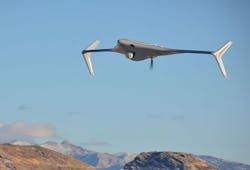Catapult-launched Bat UAV from Northrop Grumman being adapted to electronic warfare
UAV experts at the Northrop Grumman Corp. Aerospace Systems segment in Redondo Beach, Calif., demonstrated an internal miniature electronic attack payload earlier this month on the company's Bat UAV during testing at China Lake Naval Air Weapons Station in Ridgecrest, Calif.
The demonstration in October involved equipping the Bat UAV with the Northrop Grumman Pandora electronic-attack payload, which is a low-cost derivative of the company's digital APR-39 EW payloads for electronic attack, support and protection.
The demonstration involved the jamming of radars. It was the first time that such a system was used small tactical UAV, company officials say. During the demonstration, Bat flew several missions together with manned fixed-wing aircraft and other UAVs.
"Bat continues to demonstrate capabilities that can normally only be achieved by larger, more expensive unmanned aircraft," says George Vardoulakis, Northrop Grumman's vice president of Medium Range Tactical Systems.
The Bat UAV is a catapult-launched low-flying UAV operated by the U.S. Marine Corps, Navy, Air Force, and Department of Homeland Security by Swift Engineering. The UAV, which is recovered in a net, has a 10-to-12-foot wingspan and can carry payloads as heavy as 30 pounds. A Bat version with a 20-foot wingspan is being developed.
The Bat system does not need runways to operate. It is packed into a trainer and ground-control system, which are transportable by air on an MV-22 tiltrotor aircraft, and on the ground by military vehicles as small as Humvees. Two people can operate the aircraft, and its ground-control system controls the catapult launcher.
Bat has blended wings made of lightweight composite materials that merge with the fuselage into an airfoil. The unmanned aircraft has net hooks in the nose and a rear push propeller. It can fly for as long as 15 hours, flies as fast as 70 miles per hour, and can reach altitudes to 15,000 feet.
The Bat UAV can carry a variety of payloads in addition to its EW radar jammer, including still-image and real-time video cameras, infrared and synthetic aperture radar sensors, laser range finders, laser designators, communication equipment, chemical and biological detection systems, and flare dispensers.
The Bat incorporates the Hirth electronic fuel-injection engine and heavy fuel-variant, which runs on a variant of JP-8, the most widely used fuel variant within the U.S. military.
Bat is designed to be a family of affordable, medium-altitude, multi-mission UAVs that can be configured with differently-sized fuel tanks and different sensor payloads for intelligence, surveillance, reconnaissance, target acquisition, communications relay, and now electronic warfare.
For more information contact Northrop Grumman Aerospace Systems online at www.northropgrumman.com.
